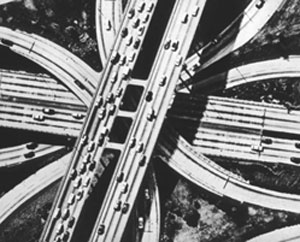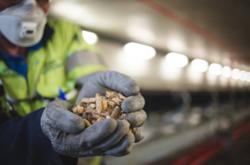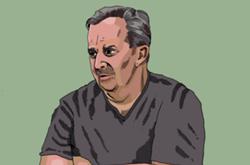
[Editor's note: This is the first of eight excerpts from Patrick Condon's new book Seven Rules for Sustainable Communities: Design Strategies for the Post Carbon World. They will run every Wednesday and Thursday for the next four weeks.]
In 2002, scientists sounded the alarm about the loss of ice on the Arctic Ocean. Global warming was affecting the Arctic climate more rapidly than anyone had previously thought possible. They predicted that if nothing was done to curb the level of greenhouse gas pouring into the atmosphere there might be no summer ice covering the North Pole by 2050.
Early in 2009, they updated their projection. Given the rate of ice loss, the new date by which the Arctic Circle will be ice free could be as soon as 2012. The loss of ice triggers other effects, none of them good. The white ice that once reflected warming sun rays no longer does so. The deep blue ocean water that takes its place absorbs those rays, warming the water and further accelerating the warming of the planet.
Bad things happen in threes. The added heat also releases methane gas that was previously trapped under polar ice. Methane gas, like carbon dioxide, traps heat in the atmosphere, but molecule per molecule it is many times more damaging. The cascading effects of climate change, previously predicted for the distant future, are already here.
Experts at the United Nations-sponsored Intergovernmental Panel on Climate Change (IPCC) all agree that the two-degree-Celsius rise in global temperature, the so-called "safe" level of warming that we will still get even if we cut GHG emissions by 80 per cent, is a rise that is unavoidable.
The IPCC predicts that, even at this "safe" temperature increase, up to 50 per cent of the planet's species will become extinct. But we are on a path where GHG produced from the burning of fossil fuels is not dropping but increasing rapidly. With a five-degree rise, much more would be lost.
What have all of these gloomy scenarios to do with a book on city design? Everything. If we change the way cities are built and retrofitted, we can prevent the blackest of the nightmare scenarios from becoming real and can create the conditions for a livable life for our children and grandchildren. It is not apocalyptic to say we can save their lives.
We often read that buildings account for about half of all GHG production; transportation, for about 25 per cent; and industry, for most of the rest. But this division obscures a fundamental point: cities are responsible for 80 per cent of all GHG -- caused by the way we build and arrange our buildings, by all the stuff we put in them, and by how we move from one building to the next. Since the problem is caused by cities, the solution should be there too.
Citizens and their elected officials have been slow to acknowledge the connection between GHG and urban form. This book may help change that. It is written for designers, policy makers, developers, regulators and ordinary citizens in the hope that it will arm them with an understanding of the ways our cities are failing and offer them very specific actions to cure them.
How did cities get this sick?
In any journey, it helps to start with a look back from where we once came. Various historical starting points could be studied, but the end of the Second World War marks the time after which cities changed the most. Many compelling reasons drove the crucial choices we made at that time; foremost among these was the need for a place to live.
After the Second World War, a variety of policy inducements provoked a massive redistribution of population across metropolitan landscapes. In the United States, the mortgage interest income tax deduction, low interest GI loans, restricting new mortgages through bank "red lining" of older residential areas and the 1956 National Interstate and Defense Highways Act, which funded the construction of the interstate highway system, were most significant.
Provoked by these inducements, middle-class and working-class families who had traditionally occupied higher density walkable and transit-served neighbourhoods fled to much lower density and car-dependent suburbs. Average densities began to fall in every North American metropolitan area, while transit ridership as a percentage of all trips began to fall with it. Older, prewar parts of the metropolitan landscape still maintained healthy transit ridership, but transit use in newer areas was near zero.
As North Americans moved from transit to cars, their per capita GHG amounts began to rise too. Of course, no one worried. GHG production was not important at that time, as the implications of this increase were not widely known and were even less widely accepted. Buying fuel for the family car was also not a concern, as prices were low. The brand-new high-speed freeways provided previously unimaginable freedom of motion, allowing workers to hold jobs 25 or more miles from home.
This was a massive change that fundamentally altered the reach of cities. In 1950, the Boston metropolitan urbanized area was only 345 square miles. In 2000, it sprawled over 1,736 square miles, a quintupling in only five decades.
During this period of dramatic metropolitan expansion, land was generally less expensive on the peripheries. This made it profitable to build residential developments ever farther away from the metropolitan centre, with single-family homes generally dropping in price as one moved farther out. This concentric reduction in house prices gave rise to the saying "drive till you qualify," a widely used phrase meaning that home buyers were induced to push a home search farther and farther from the centre of the region until their income matched the qualification requirements for the mortgage.
With so much unprecedented freedom of movement in this new urban landscape, house price became much more important than location. A distant job was easy to reach, and shopping centres catering to millions of auto nomads were soon to come. Eventually, vast stretches of the metropolitan landscape become completely car dependent, forcing individuals and families to spend more and more time behind the wheel and to rack up ever increasing vehicle-miles travelled.
The new single-family homes were not only auto dependent but, because of their shape and exposure to the elements, also inherently hard to heat. We now know that the GHG production of this style of home is up to four times greater per capita than that of home types common to older centre cities.
The problem emerges
The cracks in the system began to emerge after the 1974 "oil shock," a supply constraint caused when the OPEC nations cut off the flow of oil to the West. Spending long hours in line for gas exposed the weakness of the economy to interruptions in the flow of imported oil, by now a clearly vital resource.
At first the response was significant, provoking a shift away from larger cars and a lowering of speed limits to save fuel. But over the longer term, the lesson went unlearned.
Dependence on imported oil has increased dramatically in the intervening decades, and average fuel consumption per capita has risen sharply and steadily, only reaching a plateau in 2007. Also unfortunate: scientists who began loudly sounding the alarm about global warming at this time were largely ignored, and with the election in the United States of Ronald Reagan, a man who had no interest in energy conservation, the moment was lost.
During the 1980s and 1990s, suburban low-density development moved the United States from being a country where most of its residents lived in former streetcar-served districts, where alternatives to the car were possible, to one where the majority of residents lived in districts that were completely auto dependent.
Rather than put in place national, state and regional policies to reverse or at least mitigate an ever rising per capita use of fuel for the single passenger automobile, the reverse occurred. U.S. transportation bills from the 1970s through the 1990s favored expanding the interstates and feeder highways over transit; no policy proposals to require walking-distance access to transit and commercial services in new districts were ever seriously considered.
Canada fared somewhat better. The Canadian federal government was happy to collect a substantial gas tax but, unlike the U.S. government, was under no obligation to return it to the provinces in the form of highway funds. Thus, Canadian cities have far fewer freeway miles per capita than do U.S. cities.
Absent any national, state and provincial policies, average densities in metropolitan regions continued to drop until at least the year 2000. Exceptions were few, with Vancouver and Portland, Ore., notable among them. More numerous were the extreme examples of centrifugal forces pushing population to peripheries, impelled by vast new highway expenditures, even where regional population was stable.
Infinitely increasing car dependence
All of these forces combined to create an entirely new U.S. and Canadian urban landscape. Many thoughtful voices argue that this is a good landscape where families can find a house they can afford with a yard for the kids in a community of their own choosing. This is a strong argument, but one that can be sustained only if we are willing to forever increase the percentage of national treasures we commit to highway construction, the amount of personal wealth we pour into the gas pump, and the amount of carbon we pour into the atmosphere.
The trends are not hopeful. Per capita driving has increased alarmingly for decades, and until 2008, when fuel costs leapt briefly to over four dollars per gallon, was increasingly inelastic (meaning not responsive to market signals, such as increased fuel price).
For most people, driving is no longer a discretionary expense. They cannot just shift to walking or taking mass transit in auto-dependent landscapes; there are no sidewalks to walk on, there are no walkable destinations to walk to, and for all intents and purposes there are no buses to catch.
Auto-dominated landscapes have forced families to devote ever larger shares of their income to transportation, a share that now, for the first time in history, approaches the share consigned to paying for a home. Whereas in 1965 most families owned one car, now two cars is the norm.
The increase in two-income households has contributed strongly to this trend. The two incomes needed to pay off the mortgage on the home can be maintained only if both workers have a car to get to work. Dropping children at daycare and driving older children to otherwise inaccessible schools makes a car even more indispensable.
But it's not just "bread winners" who need a car. Everyone of driving age needs one. To be without a car in these landscapes imprisons one in the home, leading to a craving for escape with a car as the means. But in this case, escape does not mean freedom.
A landscape where walking is impossible is a landscape where our legs are used only to get from the couch to the refrigerator and from the front door to the driveway. Residents of auto-oriented suburbs walk less and weigh more than people in walkable areas.
While direct causation is difficult to definitively ascribe, the evidence is highly suggestive. The body is designed primarily for walking. If walking is systematically denied by one's environment, this cannot be a good thing. Many studies suggest that the epidemic increase in teenage obesity and alarming rise in juvenile-onset diabetes can be at least partly ascribed to the physically paralyzing influence of auto-oriented landscapes.
Climate change
Thirty per cent of the world's carbon dioxide production comes from the United States and Canada, where only about six per cent of the world's people live. Of this amount, about a quarter comes directly from transportation -- and the bulk of that from single-passenger automobiles.
This number does not include the CO2 consequences of the immense infrastructure of car manufacturing and support or the CO2 production from building the roads and highways all those cars need (concrete production is the largest single industrial producer of climate change gas, with most concrete in North America used for highway and bridge construction). Factoring in those amounts brings the CO2 share for transportation closer to 40 per cent.
The community of nations is finally agreeing that planetary meltdown can be avoided only if we cut climate change gases by 80 per cent by 2050. The United States and Canada, who have heretofore been the most reluctant of the G8 nations to acknowledge the crisis, have now agreed.
During a period when the United States alone will add 130 million more people, it is madness to assume an 85 to 90 per cent per capita reduction can be achieved unless we reverse the trend toward ever greater auto dependence. Misplaced faith in such technological quick fixes as hydrogen cars, electric cars, or switching to ethanol will not help us.
Changing to alternative energy sources will do nothing to change the fundamental entropy of our transportation choices; many other sources require huge energy inputs in their creation, lead to food scarcity in developing countries, and in the case of corn-based ethanol require more petroleum to make the fertilizer, drive the farm equipment and truck the raw materials here and there than they give back in fuel.
Reasons for hope
At this point, the problem may seem too big to solve. But all is not lost. As Robert Yaro, president of the Regional Plan Association of New York, says: "The bad news is that we have massively overbuilt the freeway system. The good news is that we have massively overbuilt the freeway system."
By the first part of this sardonic aphorism, he means that America has overinvested in a system that has, in the absence of any other land use planning controls, made a sprawling and highly inefficient urban landscape inevitable, as the excessive transportation demands that this infrastructure unleashes became impossible to satisfy.
By the second part, he means that the exact system that unleashed these forces is large and extensive enough to accommodate through infill the expected massive increases in population. If a way could be found to increase the land use intensity of all of the districts within the freeway service area to double or triple their present level (and surely, given the low coverage by buildings, such a thing should be easily possible), then per capita demand for long-distance travel should gradually drop as well.
The first step in recovery is always admitting that there is a problem and then taking responsibility for change. But proven therapies for restoring the health of a region are required.
Citizens are justifiably insecure about how and what to change. Changing the way we build regions is like changing any habitual behavior. Habitual behaviors, such as drinking, smoking or taking drugs, anesthetize us in the near term but lead to larger problems in the long term.
Building sustainable regions is the same. NIMBYism in the face of higher density development proposals is tremendously satisfying for citizens who understandably feel they have protected their community through their opposition. But the long-term effect of these actions, multiplied by many thousands of other equally habitual actions, is to worsen the disease. A set of principles -- call them rules for healing cities, if you will -- is a necessary tool for recovery.
Over the years, many others have recognized this same thing. The list of simple rules, or "steps to recovery," that forms the core of this book is not original. What is unique to this book is the attempt to simplify and order them clearly as a set of integrated urban design therapies for healing the urban landscape.
The hope is to provide citizens and leaders in the public and private sector with a simple but credible framework for action.
Seven rules for sustainable, low-carbon communities
1. Restore the streetcar city
The North American city was and is a streetcar city. Streetcar cities are characterized by easy access to transit, a wide variety of house types, and services and job sites very close at hand -- the exact elements of a sustainable city. We have largely ignored this fact. It needs rediscovering.
2. Design an interconnected street system
Fine-grain interconnected street networks ensure that all trips are as short as possible, disperse congestion and are compatible with walking, biking and transit.
3. Locate commercial services, frequent transit and schools within a five-minute walk
People will walk if there is something to walk to. The most important walking destinations are the corner store and a transit stop. A minimum gross density of 10 dwelling units per acre is required for this to work.
4. Locate good jobs close to affordable homes
The trend toward ever larger commute distances for workers must be reversed. "Good jobs close to home" is a fundamental requirement. The vast majority of new jobs in the United States and Canada are compatible with complete community districts.
5. Provide a diversity of housing types
Zoning laws have tended to segregate communities by income. Communities designed for only one income cannot be complete, and when repeated throughout the region, they add to transportation problems.
6. Create a linked system of natural areas and parks
Keeping our waters clean and our streams and rivers healthy requires a rethinking of urban drainage systems and stream protection policies. Maintaining the integrity of these systems must be a first design move when planning new communities. Far from protecting these systems through restriction, these systems must form the public space armature of new and restored communities.
7. Invest in lighter, greener, cheaper and smarter infrastructure
Suburban homes have at least four times more infrastructure per dwelling unit than do walkable streetcar neighbourhoods. Exaggerated municipal standards for roads and utilities cost too much to build and maintain, and they destroy watershed function. Smarter, cheaper and greener strategies are required.
The final rule: Love one rule, love them all
These principles represent the elements of a whole. Achieving one without the others -- particularly if it is at the expense of the others -- will be of limited value and could be counterproductive.
Tomorrow (Thursday): Rule 1 -- Restore the streetcar city ![]()
Read more: Environment, Urban Planning + Architecture

















Tyee Commenting Guidelines
Comments that violate guidelines risk being deleted, and violations may result in a temporary or permanent user ban. Maintain the spirit of good conversation to stay in the discussion.
*Please note The Tyee is not a forum for spreading misinformation about COVID-19, denying its existence or minimizing its risk to public health.
Do:
Do not: